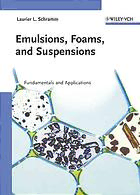
Emulsions, foams, and suspensions : fundamentals and applications PDF
Preview Emulsions, foams, and suspensions : fundamentals and applications
TharwatF.Tadros AppliedSurfactants Further Titles of Interest L.L.Schramm Emulsions, Foams, and Suspensions FundamentalsandApplications 2005 ISBN3-527-30743-5 E.Smulders Laundry Detergents 2002 ISBN3-527-30520-3 H.M.Smith(Ed.) High Performance Pigments 2002 ISBN3-527-30204-2 W.Herbst,K.Hunger Industrial Organic Pigments Production,Properties,Applications Third,CompletelyRevisedEdition 2004 ISBN3-527-30576-9 G.Buxbaum,G.Pfaff(Eds.) Industrial Inorganic Pigments Third,CompletelyRevisedandExtendedEdition 2005 ISBN3-527-30363-4 K.Hunger(Ed.) Industrial Dyes Chemistry,Properties,Applications, 2003 ISBN3-527-30426-6 Tharwat F. Tadros Applied Surfactants Applied Surfactants Principles and Applications Principles and Applications Author 9 Thisbookwascarefullyproduced.Never- theless,authorandpublisherdonotwar- Prof.Dr.TharwatF.Tadros ranttheinformationcontainedthereintobe 89NashGroveLane freeoferrors.Readersareadvisedtokeepin Wokingham mindthatstatements,data,illustrations, BerkshireRG404HE proceduraldetailsorotheritemsmay UnitedKingdom inadvertentlybeinaccurate. LibraryofCongressCardNo.:Appliedfor BritishLibraryCataloguing-in-Publication Data:Acataloguerecordforthisbookis availablefromtheBritishLibrary Bibliographicinformationpublishedby DieDeutscheBibliothek DieDeutscheBibliothekliststhispublication intheDeutscheNationalbibliografie; detailedbibliographicdataisavailableinthe Internetathhttp://dnb.ddb.dei 82005WILEY-VCHVerlagGmbH&Co. KGaA,Weinheim Allrightsreserved(includingthoseoftrans- lationinotherlanguages).Nopartofthis bookmaybereproducedinanyform–by photoprinting,microfilm,oranyother means–nortransmittedortranslatedinto machinelanguagewithoutwrittenpermis- sionfromthepublishers.Registerednames, trademarks,etc.usedinthisbook,even whennotspecificallymarkedassuch,are nottobeconsideredunprotectedbylaw. PrintedintheFederalRepublicofGermany Printedonacid-freepaper Composition AscoTypesetters,HongKong Printing StraussGmbH,Mo¨rlenbach Bookbinding Litges&DopfBuchbinderei GmbH,Heppenheim ISBN-13: 978-3-527-30629-9 ISBN-10: 3-527-30629-3 DedicatedtoourGrandchildren Nadia,Dominic,TheodoreandBruno VII Contents Preface XIX 1 Introduction 1 1.1 GeneralClassificationofSurfaceActiveAgents 2 1.2 AnionicSurfactants 2 1.2.1 Carboxylates 3 1.2.2 Sulphates 4 1.2.3 Sulphonates 4 1.2.4 Phosphate-containingAnionicSurfactants 5 1.3 CationicSurfactants 6 1.4 Amphoteric(Zwitterionic)Surfactants 7 1.5 NonionicSurfactants 8 1.5.1 AlcoholEthoxylates 8 1.5.2 AlkylPhenolEthoxylates 9 1.5.3 FattyAcidEthoxylates 9 1.5.4 SorbitanEstersandTheirEthoxylatedDerivatives (SpansandTweens) 10 1.5.5 EthoxylatedFatsandOils 11 1.5.6 AmineEthoxylates 11 1.5.7 EthyleneOxide–PropyleneOxideCo-polymers(EO/PO) 11 1.5.8 SurfactantsDerivedfromMono-andPolysaccharides 12 1.6 SpecialitySurfactants–FluorocarbonandSiliconeSurfactants 13 1.7 PolymericSurfactants 14 1.8 ToxicologicalandEnvironmentalAspectsofSurfactants 15 1.8.1 DermatologicalAspects 15 1.8.2 AquaticToxicity 15 1.8.3 Biodegradability 16 References 16 2 PhysicalChemistryofSurfactantSolutions 19 2.1 PropertiesofSolutionsofSurfaceActiveAgents 19 2.2 Solubility–TemperatureRelationshipforSurfactants 25 2.3 ThermodynamicsofMicellization 26 AppliedSurfactants:PrinciplesandApplications. TharwatF.Tadros Copyright82005WILEY-VCHVerlagGmbH&Co.KGaA,Weinheim ISBN:3-527-30629-3 VIII Contents 2.3.1 KineticAspects 26 2.3.2 EquilibriumAspects:ThermodynamicsofMicellization 27 2.3.3 PhaseSeparationModel 27 2.3.4 MassActionModel 29 2.3.5 EnthalpyandEntropyofMicellization 30 2.3.6 DrivingForceforMicelleFormation 32 2.3.7 MicellizationinOtherPolarSolvents 33 2.3.8 MicellizationinNon-PolarSolvents 33 2.4 MicellizationinSurfactantMixtures(MixedMicelles) 34 2.4.1 SurfactantMixtureswithnoNetInteraction 34 2.4.2 SurfactantMixtureswithaNetInteraction 36 2.5 Surfactant–PolymerInteraction 39 2.5.1 FactorsInfluencingtheAssociationBetweenSurfactantand Polymer 41 2.5.2 InteractionModels 42 2.5.3 DrivingForceforSurfactant–PolymerInteraction 45 2.5.4 StructureofSurfactant–PolymerComplexes 45 2.5.5 Surfactant–HydrophobicallyModifiedPolymerInteraction 45 2.5.6 InteractionBetweenSurfactantsandPolymerswithOppositeCharge (Surfactant–PolyelectrolyteInteraction) 46 References 50 3 PhaseBehaviorofSurfactantSystems 53 3.1 Solubility–TemperatureRelationshipforIonicSurfactants 57 3.2 SurfactantSelf-Assembly 58 3.3 StructureofLiquidCrystallinePhases 59 3.3.1 HexagonalPhase 59 3.3.2 MicellarCubicPhase 60 3.3.3 LamellarPhase 60 3.3.4 BicontinuousCubicPhases 61 3.3.5 ReversedStructures 62 3.4 ExperimentalStudiesofthePhaseBehaviourofSurfactants 62 3.5 PhaseDiagramsofIonicSurfactants 65 3.6 PhaseDiagramsofNonionicSurfactants 66 References 71 4 AdsorptionofSurfactantsattheAir/LiquidandLiquid/Liquid Interfaces 73 4.1 Introduction 73 4.2 AdsorptionofSurfactants 74 4.2.1 GibbsAdsorptionIsotherm 75 4.2.2 EquationofStateApproach 78 4.3 InterfacialTensionMeasurements 80 4.3.1 WilhelmyPlateMethod 80 4.3.2 PendentDropMethod 81 Contents IX 4.3.3 DuNouy’sRingMethod 82 4.3.4 DropVolume(Weight)Method 82 4.3.5 SpinningDropMethod 83 References 84 5 AdsorptionofSurfactantsandPolymericSurfactantsattheSolid/Liquid Interface 85 5.1 Introduction 85 5.2 SurfactantAdsorption 86 5.2.1 AdsorptionofIonicSurfactantsonHydrophobicSurfaces 86 5.2.2 AdsorptionofIonicSurfactantsonPolarSurfaces 89 5.2.3 AdsorptionofNonionicSurfactants 91 5.3 AdsorptionofPolymericSurfactantsattheSolid/LiquidInterface 93 5.4 AdsorptionandConformationofPolymericSurfactantsat Interfaces 96 5.5 ExperimentalMethodsforMeasurementofAdsorptionParameters forPolymericSurfactants 102 5.5.1 AmountofPolymerAdsorbedG–AdsorptionIsotherms 102 5.5.2 PolymerBoundFractionp 106 5.5.3 AdsorbedLayerThicknessdandSegmentDensityDistributionr(z) 107 5.5.4 HydrodynamicThicknessDetermination 110 References 112 6 ApplicationsofSurfactantsinEmulsionFormationandStabilisation 115 6.1 Introduction 115 6.1.1 IndustrialApplicationsofEmulsions 116 6.2 PhysicalChemistryofEmulsionSystems 117 6.2.1 ThermodynamicsofEmulsionFormationandBreakdown 117 6.2.2 InteractionEnergies(Forces)BetweenEmulsionDropletsand theirCombinations 118 6.3 MechanismofEmulsification 123 6.4 MethodsofEmulsification 126 6.5 RoleofSurfactantsinEmulsionFormation 127 6.5.1 RoleofSurfactantsinDropletDeformation 129 6.6 SelectionofEmulsifiers 134 6.6.1 Hydrophilic-LipophilicBalance(HLB)Concept 134 6.6.2 PhaseInversionTemperature(PIT)Concept 137 6.7 CohesiveEnergyRatio(CER)ConceptforEmulsifierSelection 140 6.8 CriticalPackingParameter(CPP)forEmulsifierSelection 142 6.9 CreamingorSedimentationofEmulsions 143 6.9.1 CreamingorSedimentationRates 145 6.9.2 PreventionofCreamingorSedimentation 147 6.10 FlocculationofEmulsions 150 6.10.1 MechanismofEmulsionFlocculation 150 X Contents 6.10.2 GeneralRulesforReducing(Eliminating)Flocculation 153 6.11 OstwaldRipening 154 6.12 EmulsionCoalescence 155 6.12.1 RateofCoalescence 157 6.13 PhaseInversion 158 6.14 RheologyofEmulsions 159 6.15 InterfacialRheology 162 6.15.1 BasicEquationsforInterfacialRheology 163 6.15.2 BasicPrinciplesofMeasurementofInterfacialRheology 165 6.15.3 CorrelationofInterfacialRheologywithEmulsionStability 168 6.16 InvestigationsofBulkRheologyofEmulsionSystems 171 6.16.1 Viscosity-VolumeFractionRelationshipforOil/Waterand Water/OilEmulsions 171 6.16.2 ViscoelasticPropertiesofConcentratedO/WandW/OEmulsions 175 6.16.3 ViscoelasticPropertiesofWeaklyFlocculatedEmulsions 180 6.17 ExperimentalMethodsforAssessingEmulsionStability 182 6.17.1 AssessmentofCreamingorSedimentation 182 6.17.2 AssessmentofEmulsionFlocculation 183 6.17.3 AssessmentofOstwaldRipening 183 6.17.4 AssessmentofCoalescence 183 6.17.5 AssessmentofPhaseInversion 183 References 184 7 SurfactantsasDispersantsandStabilisationofSuspensions 187 7.1 Introduction 187 7.2 RoleofSurfactantsinPreparationofSolid/LiquidDispersions 188 7.2.1 RoleofSurfactantsinCondensationMethods 188 7.2.2 RoleofSurfactantsinDispersionMethods 193 7.3 EffectofSurfactantAdsorption 199 7.4 WettingofPowdersbyLiquids 201 7.5 RateofPenetrationofLiquids 203 7.5.1 Rideal–WashburnEquation 203 7.5.2 MeasurementofContactAnglesofLiquidsandSurfactantSolutions onPowders 204 7.6 StructureoftheSolid/LiquidInterface 204 7.6.1 OriginofChargeonSurfaces 204 7.7 StructureoftheElectricalDoubleLayer 206 7.7.1 DiffuseDoubleLayer(GouyandChapman) 206 7.7.2 Stern–GrahameModeloftheDoubleLayer 207 7.8 ElectricalDoubleLayerRepulsion 207 7.9 VanderWaalsAttraction 208 7.10 TotalEnergyofInteraction:Deryaguin–Landau–Verwey–Overbeek (DLVO)Theory 210 7.11 CriteriaforStabilisationofDispersionswithDoubleLayer Interaction 211 Contents XI 7.12 ElectrokineticPhenomenaandtheZetaPotential 212 7.13 CalculationofZetaPotential 214 7.13.1 VonSmoluchowski(Classical)Treatment 214 7.13.2 Hu¨ckelEquation 215 7.13.3 Henry’sTreatment 215 7.14 MeasurementofElectrophoreticMobility 216 7.14.1 UltramicroscopicTechnique(Microelectrophoresis) 216 7.14.2 LaserVelocimetryTechnique 217 7.15 GeneralClassificationofDispersingAgents 217 7.15.1 Surfactants 218 7.15.2 NonionicPolymers 218 7.15.3 Polyelectrolytes 218 7.16 StericStabilisationofSuspensions 218 7.17 InteractionBetweenParticlesContainingAdsorbedPolymer Layers 219 7.17.1 MixingInteractionG 220 mix 7.17.2 ElasticInteraction,G 221 el 7.18 CriteriaforEffectiveStericStabilisation 224 7.19 FlocculationofStericallyStabilisedDispersions 224 7.20 PropertiesofConcentratedSuspensions 225 7.21 CharacterisationofSuspensionsandAssessmentoftheir Stability 231 7.21.1 AssessmentoftheStructureoftheSolid/LiquidInterface 231 7.21.2 AssessmentoftheStateoftheDispersion 234 7.22 BulkPropertiesofSuspensions 235 7.22.1 EquilibriumSedimentVolume(orHeight)andRedispersion 235 7.22.2 RheologicalMeasurements 236 7.22.3 AssessmentofSedimentation 236 7.22.4 AssessmentofFlocculation 239 7.22.5 TimeEffectsduringFlow–Thixotropy 242 7.22.6 ConstantStress(Creep)Experiments 243 7.22.7 Dynamic(Oscillatory)Measurements 244 7.23 SedimentationofSuspensionsandPreventionofFormation ofDilatantSediments(Clays) 249 7.24 PreventionofSedimentationandFormationofDilatant Sediments 253 7.24.1 BalanceoftheDensityoftheDispersePhaseandMedium 253 7.24.2 ReductionofParticleSize 253 7.24.3 UseofHighMolecularWeightThickeners 253 7.24.4 Useof‘‘Inert’’FineParticles 254 7.24.5 UseofMixturesofPolymersandFinelyDividedParticulate Solids 254 7.24.6 DepletionFlocculation 254 7.24.7 UseofLiquidCrystallinePhases 255 References 256
